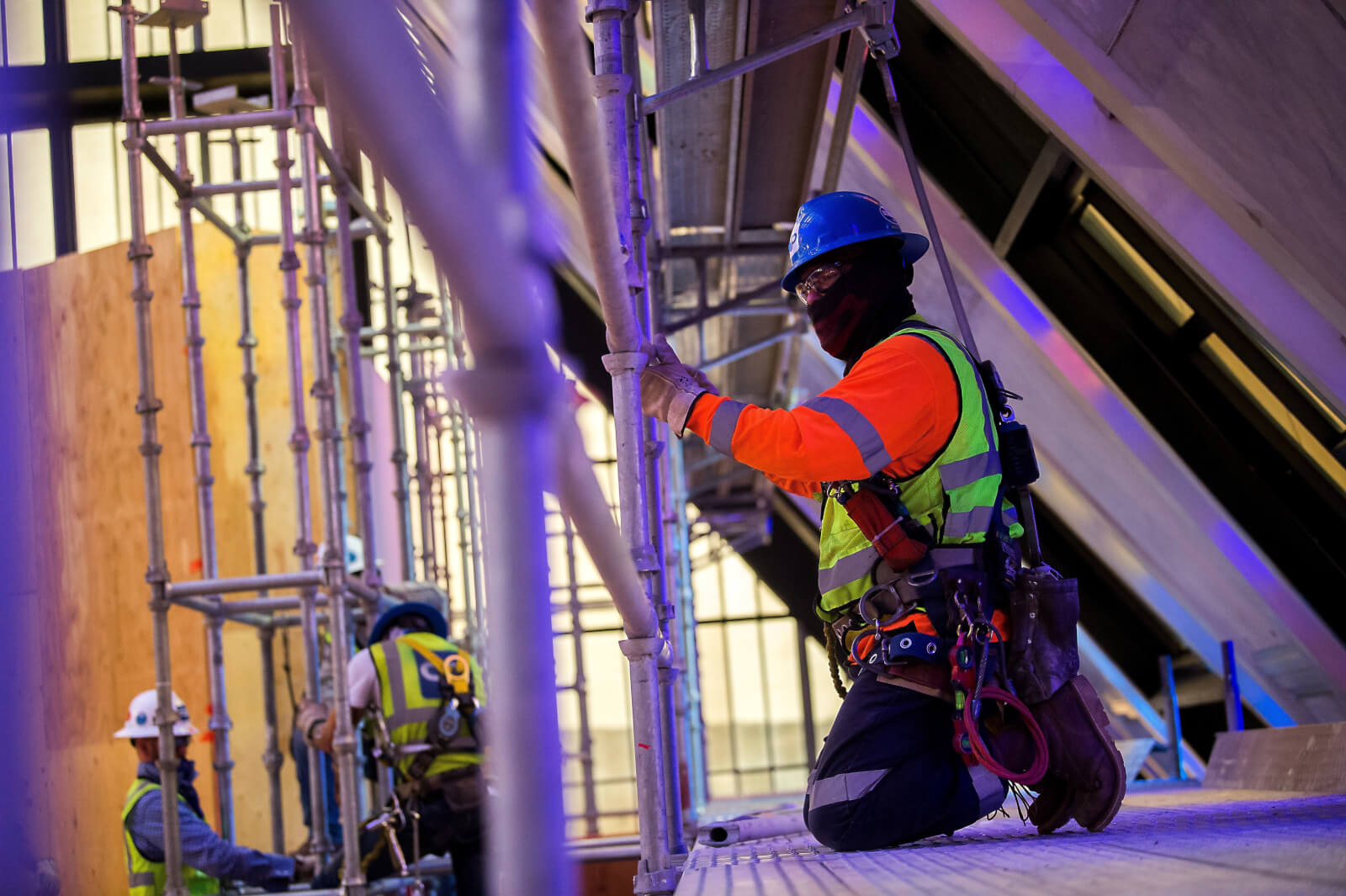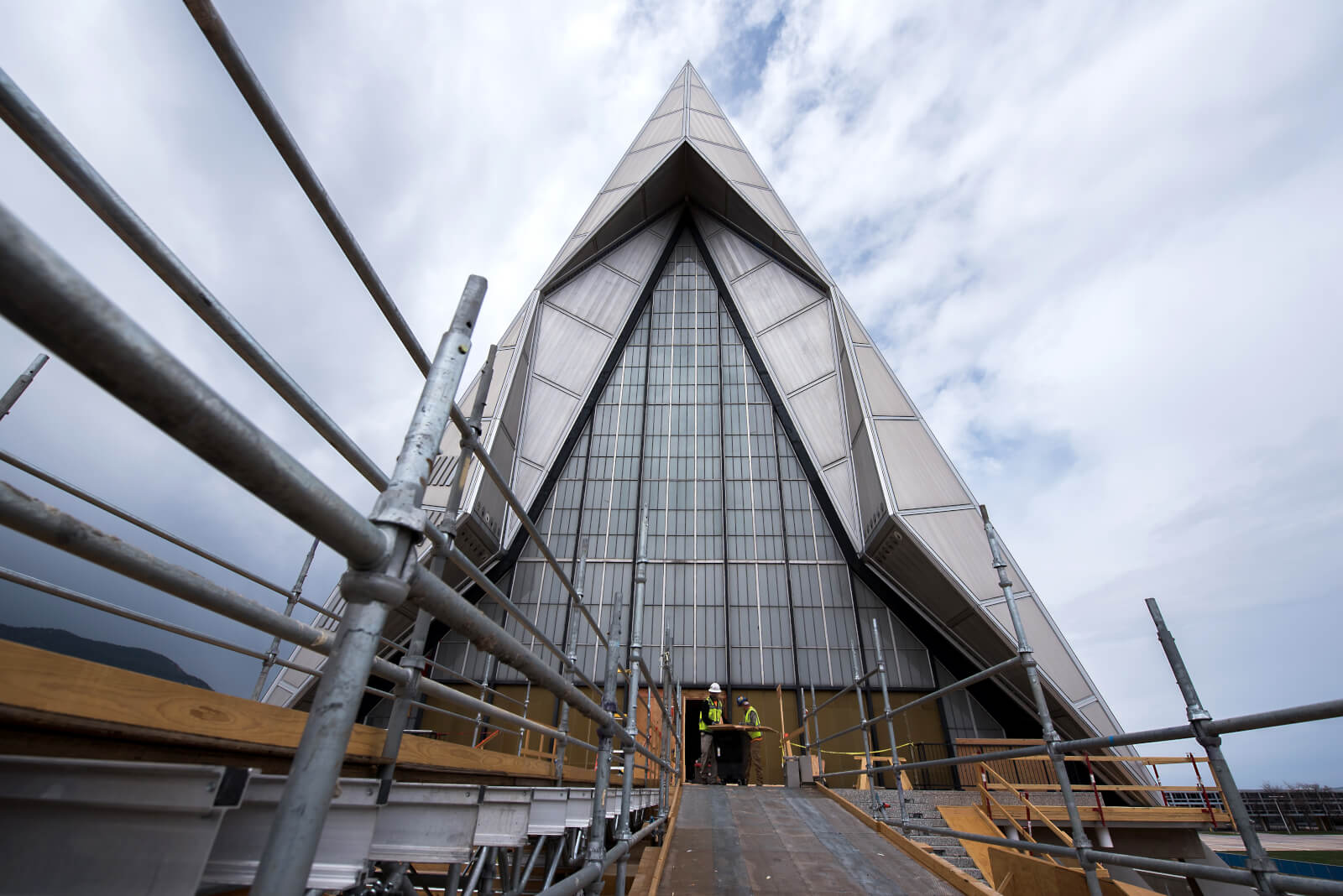Progress to renovate, restore Cadet Chapel is ongoing today
 (U.S. Air Force photo/Trevor Cokley)
(U.S. Air Force photo/Trevor Cokley)
Story by Mila Cisneros, Air Force Installation and Mission Support Center Public Affairs, Aug. 24, 2020
JOINT BASE SAN ANTONIO-LACKLAND, Texas – The Air Force Civil Engineer Center is renovating an iconic Air Force symbol: the Cadet Chapel at the Air Force Academy.
The $158 million project aims to fix structural damage to eliminate a longstanding leakage problem after years of ineffective smaller repair efforts.
The AFCEC is also managing rehabilitation on the 52,000-square-foot building while retaining its original character and defining elements. This includes the 17 steel spires of tetrahedrons, which soar to a height of 150 feet and are visible for miles.
“The Cadet Chapel is a symbol of the spiritual strength of Airmen,” said Col. John Norton, director of AFCEC’s Facility Engineering Directorate. AFCEC is proud to be working closely with the Air Force Installation Contracting Center and the Academy on this awesome effort to restore the chapel.”
Built in 1963, the chapel serves as an inter-faith house of worship.
While its value to the Air Force is significant, the Cadet Chapel has a far broader importance. Registered as a National Historic Landmark, it has become a significant part of America’s architectural heritage when it received a Twenty-Five-Year Award from the American Institute of Architects in 1996.
“The Twenty-Five-Year Award is the most significant recognition given to a building and documents its place in our heritage. Until that time no other fully funded federal project had received the prestigious honor,” said Duane Boyle, the Academy’s campus architect.
“The chapel represents the best in architectural ingenuity and its restoration back to its original appearance will ensure that it remains for the nation to enjoy,” Boyle added.
The AFCEC teamed with the Academy and the 10th Air Base Wing — the Academy’s host unit — to repair the exterior structure and restore the extensively damaged interior of the most visited manmade attraction in Colorado.
AFCEC awarded the contract in July 2019. After the pre-construction phase, renovations began in October 2019 are expected to be complete by the spring of 2024.
“We are taking the chapel down to its steel bones, restoring the stained glass, the Protestant and Catholic pipe organs, and the Protestant pews, and then rebuilding the entire exterior,” said JD Buchholtz, AFCEC project manager.
Workers are now stripping the building to its steel support skeleton.
“What has taken a significant amount of the effort up to this point is the planning and coordination of how to take the design for this repair and turn it into detailed plans, giving the contractor team step-by-step procedures for the work,” Buchholtz said. “As we go, we are also validating each step to meet the intents of stopping the leaks and maintaining the historic look.”
While the enclosure goes up, the interior renovation is already in progress with the removal of the chapel’s wooden pews, Catholic organ and the main Protestant organ — a massive instrument of about 4,500 organ pipes – already complete.
The stained glass will be removed, and cleaned and restored by the same family-owned company that did the original work in a California restoration facility.
It’s an exacting but vital part of the repair process with over 2,200 cassettes of glass — each cassette with between nine and 12 different panes of glass, Buchholtz said.
“Any existing broken glass will need to be repaired, and if a piece of glass cannot be repaired, it will be replaced with an approved matching piece,” Buchholtz said, before all pieces will be reassembled and put back into the same original.
Although there is a risk of the COVID-19 pandemic affecting the renovation, AFCEC is taking measures to minimize it.
“While it is difficult to foresee, so far, we have been able to keep COVID-19 from causing any direct project delays. Our close partnership and communication with the Air Force Academy is essential to keep construction moving and has helped greatly to keep this important project on schedule,” Buchholtz said.

(U.S. Air Force photo/Trevor Cokley)